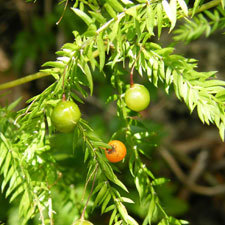 Climbing asparagus
Climbing asparagus
Common name: Climbing asparagus
Botanical name: Asparagus scandens
Management programme: Sustained Control Rule 5
Originates from South Africa and was introduced to New Zealand as an ornamental garden plant. The name asparagus originates from Greek with sparasso translating to ‘to tear’ referring to the prickles of some species.
Why is it a pest?
- It forms dense patches on the ground and in the sub-canopy in most forest types with tough, long-lived tubers that re-sprout easily, particularly through dumped vegetation and contaminated soil.
- Climbing asparagus can ring bark and kill soft-barked shrubs and trees, and invades areas where epiphytes are usually found.
- Carpets forest floor and prevents regrowth of native seedlings.
- Very shade tolerant and fast growing.
Where is it found?
Climbing asparagus is scattered throughout the Bay of Plenty. It is found in forest remnants, regenerating forest, grassy places, rock walls, and hedges. The seeds are bird dispersed and will resprout from dumped vegetative fragments.
What does it look like?
- A slender, scrambling or climbing perennial with green multibranched stems up to 2m long which twine readily.
- Fine, fern-like foliage, small delicate leaves attached to hook vines.
- Leaves are narrow and lance-shaped, flattened, and curved cladodes which are in threes at each node 5-15mm long.
- Stems are green and strongly bind to support being multi branched at the top.
- Tiny white flowers appear from September to December, followed from October to February by round berries (8mm in diameter) that ripen from green to orange-red and contain 1-2 seeds each.
- It is very similar to bushy asparagus; however, bushy asparagus has larger, spiny leaves and thicker stems.
What are the rules?
Sustained Control
Climbing Asparagus is a Sustained Control pest. Sustained Control pests are well established in the region and preventing the spread is no longer a realistic objective. Management focuses on reducing general impacts of the pest. Landowners/ occupiers are responsible for the control of these pest species on their land. Council may enforce control.
Rules require land occupiers to destroy any Climbing Asparagus on their properties that is within 200m of any property boundary where the adjoining occupier is also controlling the pest plant.
How do you get rid of it?
Recommended:
Maintain a rolling front of control, working in from the edge of the infestation. Follow up will be required 6-monthly. Replant to establish ground cover.
- Dig out tubers and dispose of appropriately where they cannot resprout
- Spray spring to early summer only, with herbicide, no penetrant is needed if spraying against tree trunks. Only spray lightly, avoid run-off.
Climbing asparagus is difficult to control. Stem fragments readily resprout when broken off in the ground and tubers will often resprout following spraying. Follow up treatment will be required every 6 months.
CAUTION: When using any herbicide or pesticide, PLEASE READ THE LABEL THOROUGHLY to ensure that all instructions and directions for the purchase, use and storage of the product, are followed and adhered to.
Read more on pest control advice, information and regulations.
Images




